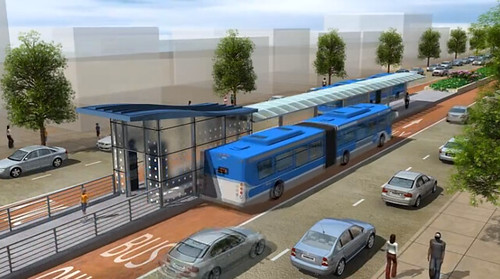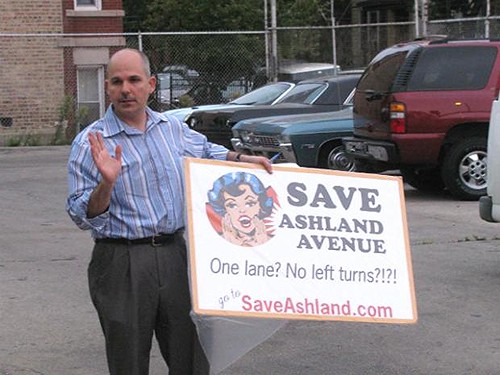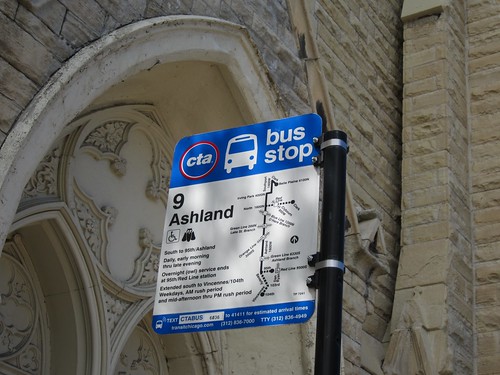Guest contributor Lindsay Bayley lives with her husband in the Noble Square neighborhood, steps from the future Ashland bus rapid transit corridor, and is a year-round bicycle commuter. She works as a senior planner with the Chicago Metropolitan Agency for Planning (CMAP), specializing in parking policy. The views expressed here do not represent CMAP's stance on BRT but rather Lindsay's perspective as a resident.
Last Friday a friend and I showed up for a meeting of the Ashland-Western Coalition -- a group that opposes plans for bus rapid transit -- at the First Baptist Congregational Church, 1613 West Washington, which we assumed was open to the public. When we arrived, AWC leader Roger Romanelli recognized me from the last meeting I attended, and remembered me as a supporter of BRT. After some private consultation between Roger and the handful of other attendees, it became clear that no new coalition business would be discussed while we were present, but we did spend some time debating the merits of the Chicago Transit Authority plan to bring rapid bus service to Ashland.
Roger asked my friend and me why BRT supporters think the CTA's plan is a good idea. We gave a myriad of answers. I told the coalition members that my husband and I don’t own a car, and BRT would improve our access to businesses in the city, conveniently connecting us to other neighborhoods and train lines. My friend told them about how she used to live in Cleveland, where they implemented BRT along Euclid Avenue and how it completely transformed the area for the better. Since BRT was implemented, ridership along Euclid Avenue has increased by 60 percent and the area saw $4.3 billion in real-estate investments.
As for their question, “Why Ashland?," I referred them to the Metropolitan Planning Council report on bus rapid transit and the CTA’s fact sheet. Ashland is the most-traveled bus corridor in the city, connecting seven CTA ‘L’ stations and two Metra stations, and the street also includes several different business and retail corridors, plus the Illinois Medical District. Compared to Western Avenue, which was also under consideration for BRT, Ashland’s curb-to-curb right-of-way, 70 feet, is slightly wider overall. Also, the Ashland bus currently operates about one mile-per-hour slower than the Western bus, so BRT there provides the opportunity to make the most significant improvements for the largest number of people.
Roger argued that Chicago is not Cleveland, and that Ashland Avenue is “thriving.” He wanted more examples of BRT success stories, but no matter which example you cite -- Mexico City, for instance -- an opponent can always say, “But Chicago is not (insert name of city here),” since Chicago has no examples of true BRT yet.
The coalition members' comments at the meeting made it clear that they’re ill-informed about the CTA’s plan and are spreading misinformation to other community members. AWC members told me that there will be no pedestrian crossings at intersections without traffic lights, and that the city is planning to build a wall down the middle of the street. However, Joe Iacobucci, the CTA's manager of strategic planning and policy, confirmed that existing pedestrian crossings will remain in place. Crossing the street will in fact be safer and easier thanks to the addition of pedestrian medians.
Romanelli claimed that Ashland is a designated truck route, but this is also untrue. IDOT’s Getting Around Illinois map indicates local north/south truck routes are Western Avenue (between I-290 and I-90/94), a small section of Halsted Street, and Cicero Avenue. The coalition members complained that much of the curbside parking along Ashland would be removed. I responded that the CTA has stated that 92 percent of the parking will be preserved, but the members don’t believe it will be.
The coalition folks told me that first responders will not be allowed to make left turns, which is also false. The BRT buses will yield to first responder vehicles with activated lights and sirens. The members are also worried about the loss of trees from the median plantings, but the CTA says all existing planted medians will be retained and 50,949 linear feet of new planted medians will be added.
Finally Roger told my friend and me that the AWC likes to keep their meetings to an hour (not what I’ve heard), and said thanks, goodbye. As we were heading out, he said he had additional business to talk about with one of the attendees. So my friend and I left, everyone else stayed, and then, I presume, the coalition members had their real meeting.






